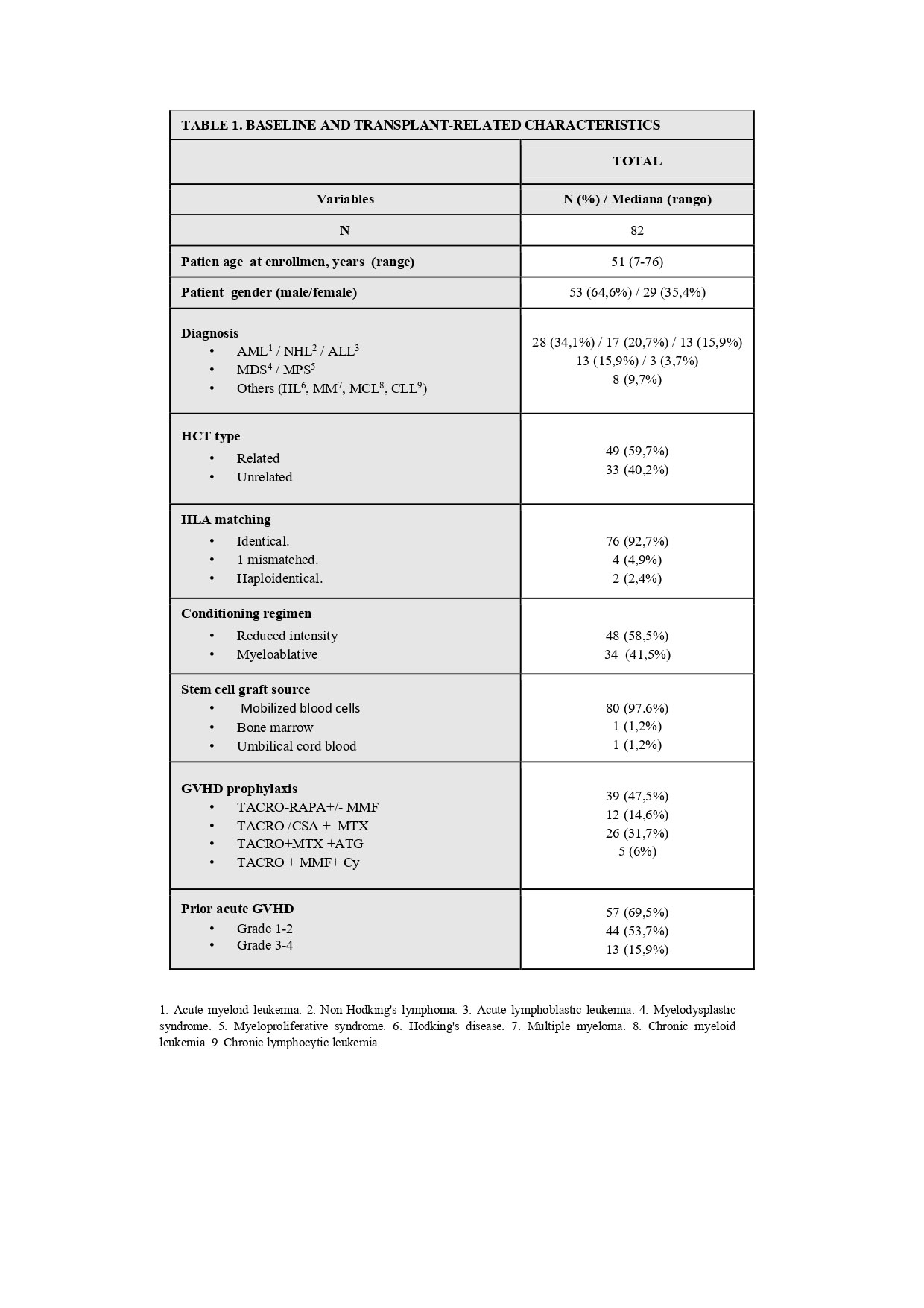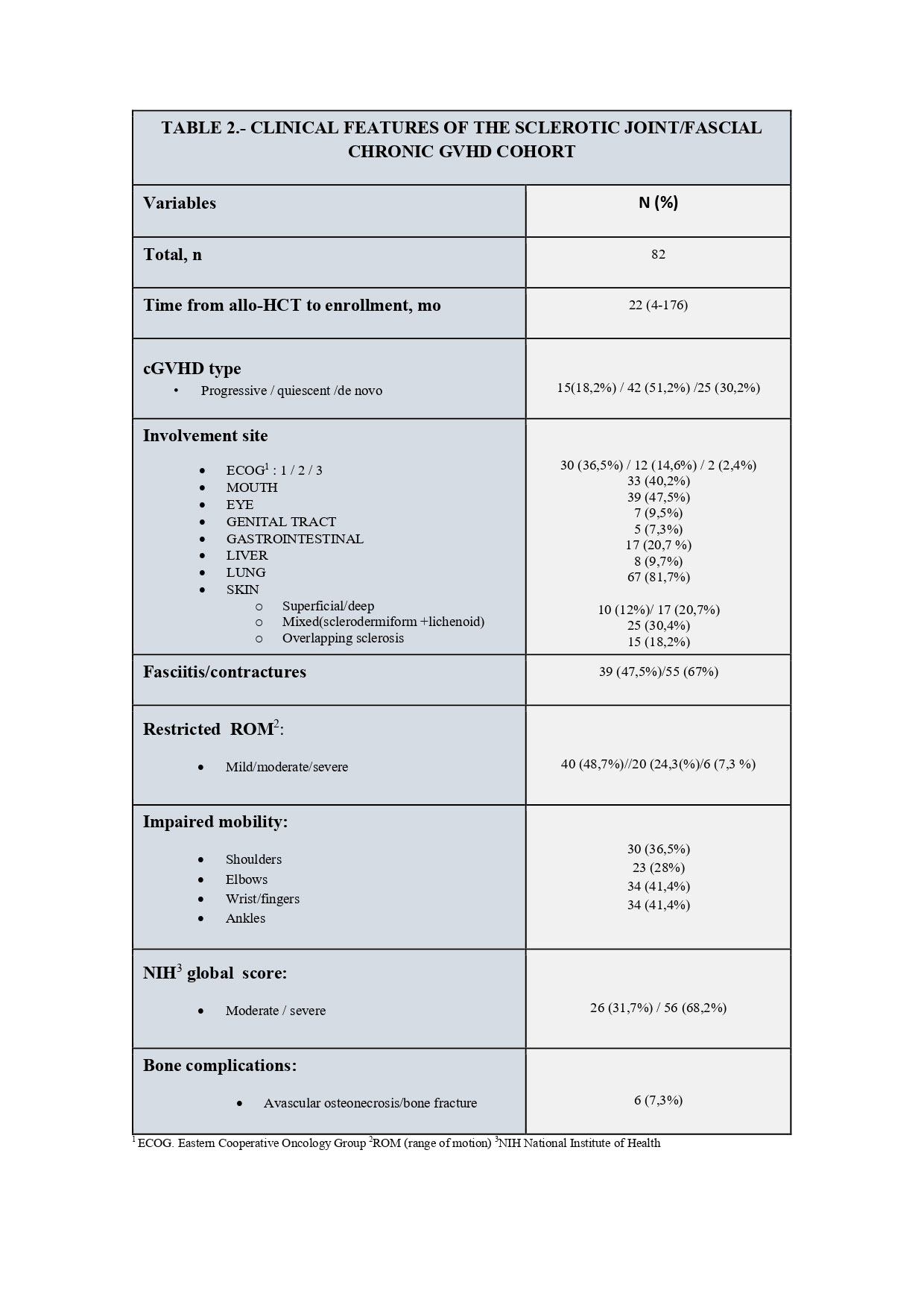Session Information
Session Type: Poster Session B
Session Time: 9:00AM-10:30AM
Background/Purpose: Graft-versus-host disease (GVHD) is the most frequent complication after allogeneic hematopoietic cell transplantation (allo-HCT). Its chronic form usually involves a multisystemic syndrome that reflects a complex immune response with varying degrees of inflammation, immune dysregulation and fibrosis, responsible for the characteristic clinical manifestations of the disease. Joint and fascial involvement represents one of the most complicated areas, often unnoticed or poorly assessed, which negatively impacts the physical function and quality of life of these patients. The aims is to describe the clinical-biological characteristics of 82 patients with chronic sclerotic-type GVHD with joint/fascial involvement evaluated in a multidisciplinary consultation.
Methods: Descriptive and retrospective observational study to describe the initial and follow-up presence of musculoskeletal manifestations diagnostic of cGVHD in a cohort of 118 patients included in the database. The clinical characteristics of the 82 patients with an established diagnosis of sclerotic cGVHD with fascial/articular involvement are detailed (Figure 1). Demographic variables are collected along with baseline disease and transplant-related characteristics and in a systematic way the assessment according to diagnostic criteria of the North American National Institute of Health (NIH) 2015 highlighting: range of motion (ROM) and photographic range of motion (P-ROM) scales. Descriptive and frequency statistical analysis was performed using the SPSS version 25 statistical package.
Results: Eighty-two (69.4%%) patients met defined diagnostic criteria for sclerotic GVHD with musculoskeletal involvement during follow-up. Fifty-three (64.6%) men, with a mean age of 51 years (range 7-76), Acute myeloid leukemia was the reason for transplantation in 28 (34.1%)%) followed by non-Hodgkin’s lymphoma in 17 (20.7%). In 49 (59.8%) patients it was performed from a related donor and with reduced intensity conditioning in 48 (58.5%) (Table 1). The mean time from transplantation to the first visit was 22 months (range 4 -176). Table 2 details the clinical manifestations of cGVHD, highlighting that skin and joint/fascial involvement were the most frequent, more than 80% of patients, and 15 (18,2%) presented isolated joint contractures secondary to sclerosis without detectable scleroderma/fasciitis. More than 50% (44) of the patients presented at some time during their evolution alteration of the general condition measured by ECOG (Eastern Cooperative Oncology Group). Bone complications appeared in 6 (7.3%) patients in relation to chronic corticotherapy.
Conclusion: Joint/fascial involvement secondary to sclerosis is very frequent in our cohort, with deleterious repercussions on physical function. It is necessary to recognize and evaluate it early with validated scales. The search for new biomarkers associated with fibrosis, the use of advanced imaging techniques and a multidisciplinary approach including physiotherapy programs may help to improve the prognosis of patients with sclerotic -type cGVHD.
To cite this abstract in AMA style:
Hidalgo C, Roman C, Compan O, Pastor Navarro S, Ibañez M, Miguel B, Sanchez M, Pantoja L, Montilla C, López-Corral L. Clinical Characterization of a Cohort of Patient with Sclerotic-type Chronic Graft-versus-host Disease with Fascial/joint Involvement [abstract]. Arthritis Rheumatol. 2022; 74 (suppl 9). https://acrabstracts.org/abstract/clinical-characterization-of-a-cohort-of-patient-with-sclerotic-type-chronic-graft-versus-host-disease-with-fascial-joint-involvement/. Accessed .« Back to ACR Convergence 2022
ACR Meeting Abstracts - https://acrabstracts.org/abstract/clinical-characterization-of-a-cohort-of-patient-with-sclerotic-type-chronic-graft-versus-host-disease-with-fascial-joint-involvement/


